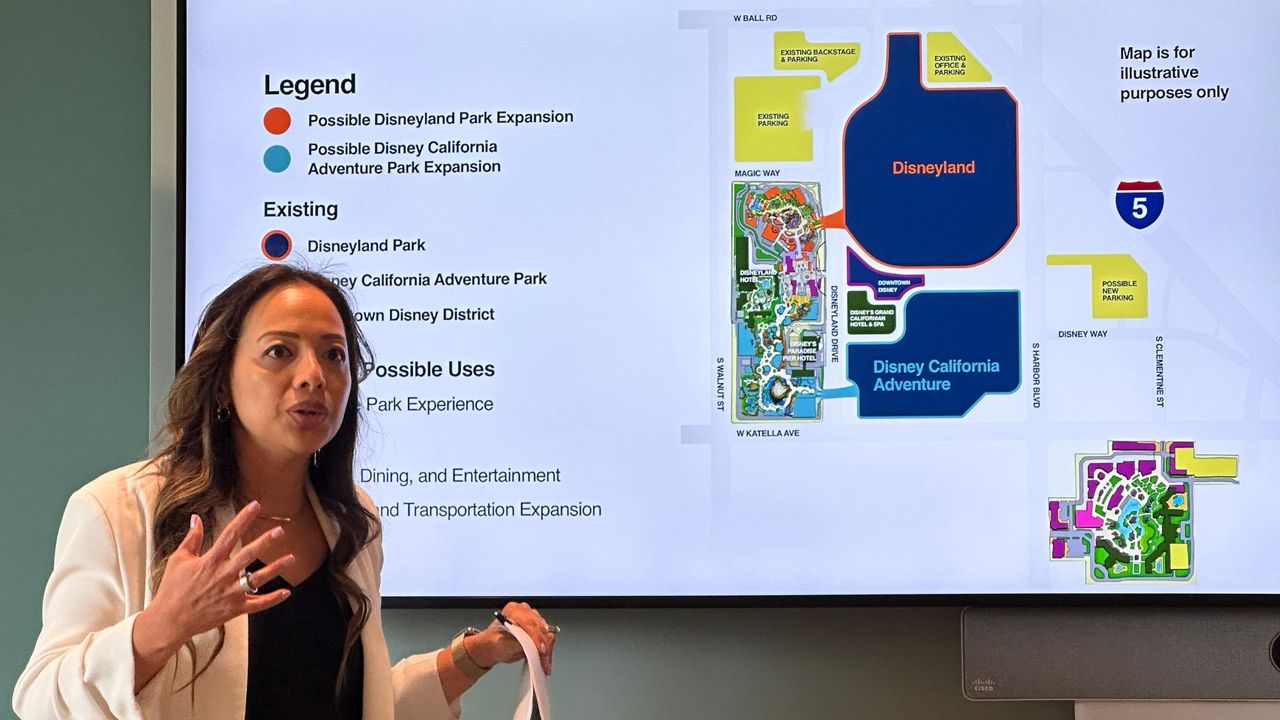ANAHEIM, Calif. — With possible plans for a monorail connector, a 17,000-stall parking structure, and pedestrian bridges, the Disneyland Resort could see major changes in the long-distant future as they lay the groundwork to expand.
The city of Anaheim Thursday released the much-anticipated draft of the environmental impact report for Disneyland Resort's DisneylandForward project.
The proposed DisneylandForward rezoning plan would allow Disney to expand the theme park within its 490-acre footprint in Anaheim, potentially opening up possibilities for new Disney-themed hotels, rides, entertainment and attractions.
"We are charting a path for the next four decades of growth of Disneyland Resort," said Rachel Alde, the vice president of Global Development at Disney.
Alde and other Disney officials met with a small group of reporters Thursday to discuss "the milestone" of the rezoning project two and half years in the making.
Disneyland officials began working with the city on the rezoning plan in 2021.
Disney wants to rezone the 490-acre Disneyland Resort as mixed-use instead of its current zoning. Anaheim, like most cities, designates land parcels with specific zoning.
The city and Disney's current master plan agreement has been around since the 1990s. The current EIR has allowed Disney to build Disney California Adventure, Downtown Disney and the Grand Californian Hotel and Spa.
But times have changed. Consumers are looking for more integrated and immersive experiences, said Alde.
Changing zoning designations, from parking to mixed-use, gives Disney more flexibility and allows Disney Imagineers to integrate hotels, restaurants and attractions on their property.
The city required Disney to pay for an environmental impact report to analyze potential impacts on transportation, noise, public services, utilities, air quality and other areas.
According to the draft EIR released by the city, Disneyland Resort currently has 97 acres designated as a hotel district, 292 acres for theme park space and attractions, 57 acres for parking and nearly 25 acres for future expansion.
The proposed plan asks the city to expand Disneyland Resort's current 292 acres designated as a theme park district to 389 acres and allow them to build hotels, parking, restaurants, retail and office spaces in a new theme park district.
"We're taking old approvals and spreading them across our footprint," said Alde. "This allows us to continue to invest in the city of Anaheim. We're not seeking public funding or asking for additional square footage. We're utilizing the same square footage. We just want to spread those entitlements to different land parcels."
According to the draft EIR and renderings, Disney wants to rezone the Simba lot on the west side of Disneyland Resort and the Toy Story lot across the street from the Anaheim Convention Center. The Simba and Toy lots are currently used as parking.
Rezoning those areas could allow for the expansion of Disneyland, Disney California Adventure, or "new attractions," Disney officials said.
Other interesting tidbits from the draft EIR include:
- The creation of a new 17,000-stall parking structure on the east of Disneyland Resort or Harbor side of the park.
- Disney's plan to build up to three pedestrian bridges over Harbor Boulevard between Manchester Avenue and Disney Way.
- The monorail and guest transportation systems will move guests from the Hotel District to the Theme Park District. Future connections may also be provided to the future expansion district.
When asked about the expansion of the monorail, Disneyland officials were “noncommital.”
With the release of the draft EIR, the city will begin a 45-day public review period until the end of October. Disney will then hold a public workshop before the city releases the final subsequent environmental impact report.
The report will then go to the planning commission to vote on before moving to the city council.
Disney officials said the goal is to have DisneylandForward voted on by the end of 2024.



